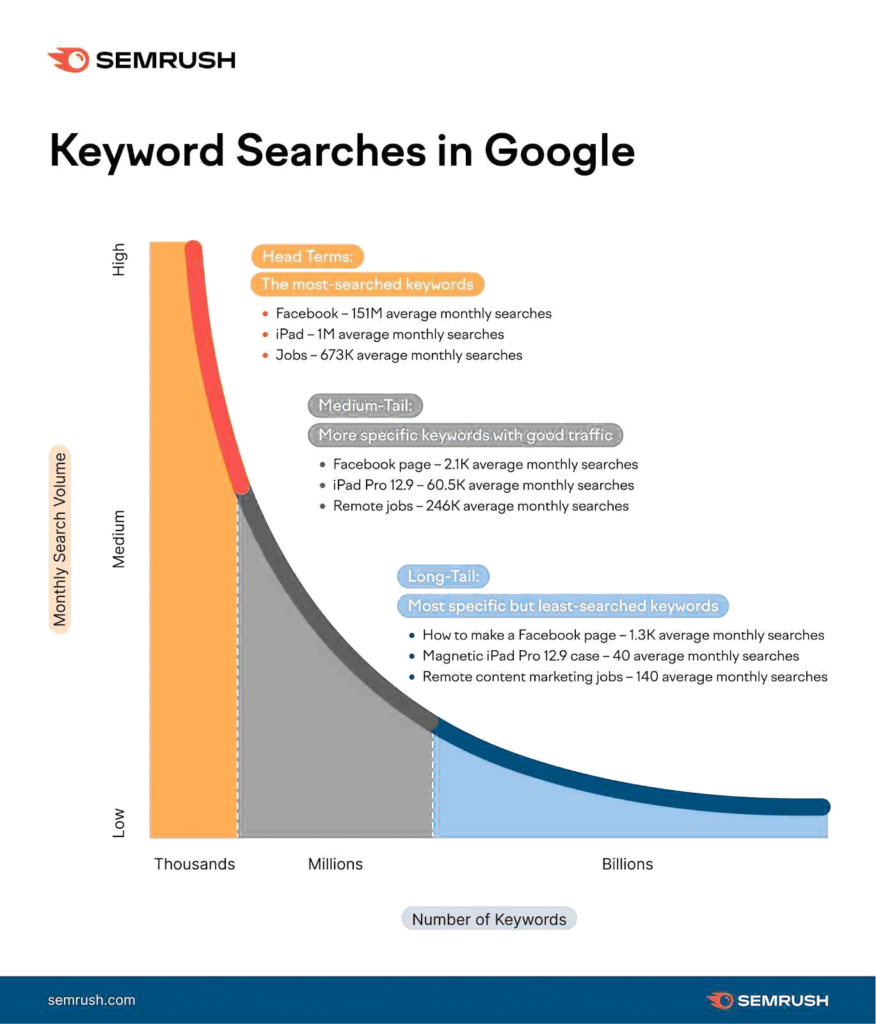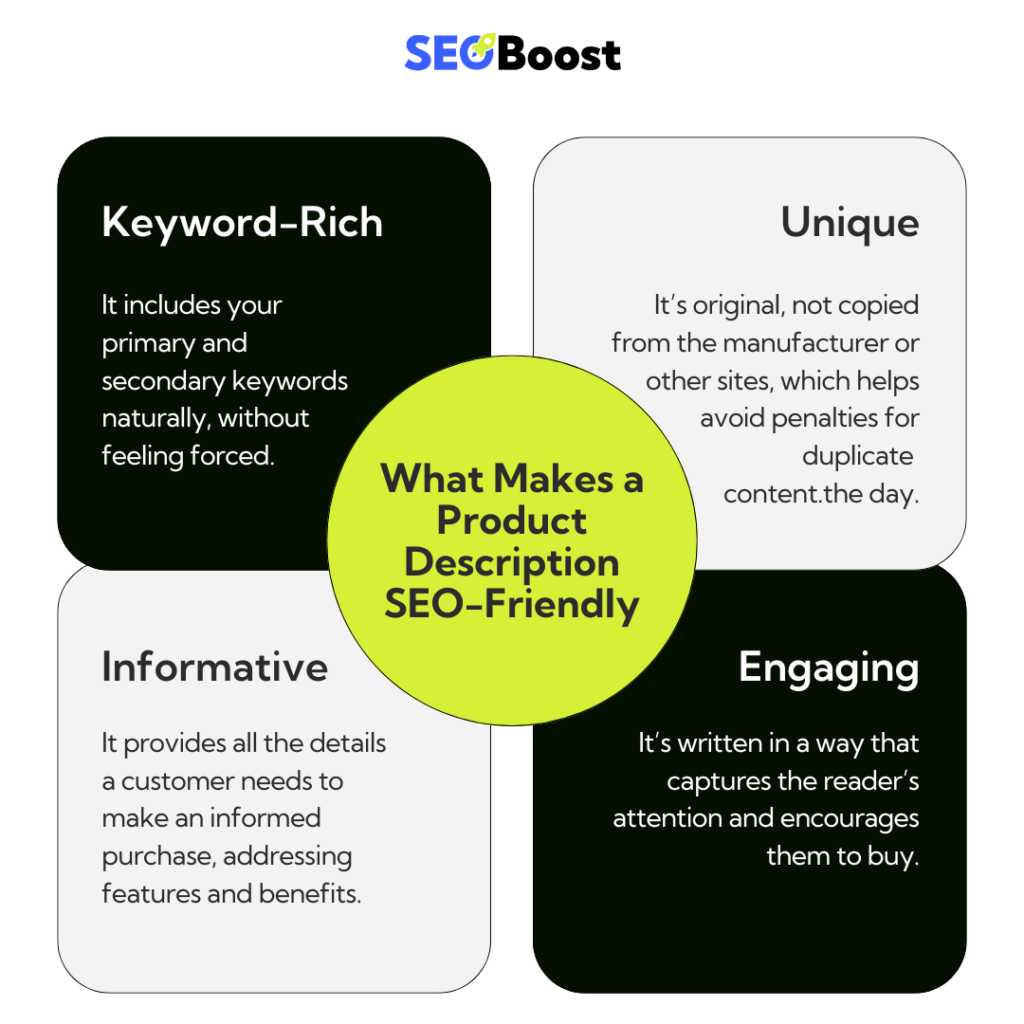The Ultimate Guide to Creating SEO-Friendly Content for E-commerce

Picture this: you’ve got an amazing e-commerce site, packed with products you know people will love. But how do you get those products in front of the right eyes without spending a fortune on ads? The answer lies in mastering SEO content. By writing content that’s not just informative but also optimised for search engines, you can attract a steady stream of organic traffic—and those visitors are often the ones who are ready to buy.
In this guide, we’ll break down everything you need to know about crafting SEO-friendly content for your e-commerce site. From finding the right keywords to optimising product descriptions, category pages, and blogs, we’ll cover it all. And we’ll keep it easy to follow, practical, and yes—even a little fun.
Ready to turn your content into a sales-driving machine? Let’s dive in.
Key Topics
What Is SEO Content, and Why Does It Matter for E-commerce?
First things first—let’s make sure we’re all on the same page. What exactly is SEO content, and why should you care about it if you’re running an e-commerce site?
What Is SEO Content?
SEO (Search Engine Optimisation) content is any piece of content that’s designed to rank well in search engines like Google. It’s created with specific keywords in mind, structured for readability, and crafted to meet the needs of your target audience. For an e-commerce site, this includes everything from product descriptions and category pages to blog posts and landing pages.
Why Is SEO Content Important for E-commerce?
You might have the best products in the world, but if no one can find them, your sales will suffer. That’s where SEO content comes in. Here’s why it’s crucial:
- Drives Organic Traffic: When your content ranks high in search results, it attracts people who are actively searching for products like yours. This can lead to a steady flow of visitors without the ongoing cost of paid ads.
- Builds Trust and Credibility: High-ranking content signals to users that your site is trustworthy and authoritative, which can help build customer confidence.
- Increases Conversion Rates: SEO content isn’t just about attracting visitors—it’s about converting them into customers. Well-crafted content that addresses customer needs and questions can lead to higher conversion rates.
- Long-Term Benefits: Unlike paid advertising, which stops when your budget does, SEO content continues to attract visitors over time, making it a cost-effective long-term strategy.
How to Find the Right Keywords for Your E-commerce Site
Alright, let’s get into the nitty-gritty. Keywords are the foundation of SEO content. They’re the words and phrases your potential customers are typing into Google when they’re looking for products like yours. But how do you figure out which keywords to target?
What Are Long-Tail Keywords, and Why Should You Care?
When it comes to e-commerce, long-tail keywords are your best friends. These are longer, more specific phrases that typically have lower search volumes but higher conversion rates. For example, instead of targeting a broad keyword like “laptops,” you’d go for something more specific like “best gaming laptops under £1000.”
Why are long-tail keywords so important?
- Less Competition: Because long-tail keywords are more specific, there’s usually less competition for them, making it easier for your content to rank.
- Higher Intent: These keywords often reflect a user who’s further along in the buying process, meaning they’re more likely to convert.
- Better Targeting: Long-tail keywords help you reach a more specific audience, which can lead to better engagement and more sales.

How Do You Find the Best Keywords for Your E-commerce Site?
Here’s how to start your keyword research journey:
- Brainstorm Seed Keywords: Start by jotting down basic terms related to your products. If you sell fitness gear, for example, your seed keywords might include “yoga mats,” “dumbbells,” and “resistance bands.”
- Use Keyword Research Tools: Tools like Google Keyword Planner, Ahrefs, and SEMrush are great for finding related keywords, search volumes, and keyword difficulty. Plug in your seed keywords and explore what comes up.
- Spy on Your Competitors: Check out the keywords your competitors are ranking for. This can give you insights into what’s working in your niche and help you identify opportunities they might be missing.
- Think About Search Intent: Make sure the keywords you choose match what your customers are actually looking for. For example, someone searching “how to use resistance bands” is likely seeking information, while “buy resistance bands online” indicates they’re ready to make a purchase.
- Create a Keyword List: Organise your keywords into a list that includes primary and secondary keywords for each page on your site. Your primary keywords should be the main focus, while secondary keywords support the content and add depth.
Now that you’ve got your keywords in hand, let’s talk about how to weave them into your product descriptions.
How to Write SEO-Friendly Product Descriptions

Tips for Crafting SEO-Optimised Product Descriptions
- Naturally Integrate Keywords: Place your primary keyword in the product title and within the first 100 words of the description. Sprinkle secondary keywords naturally throughout the content—just don’t overdo it.
- Focus on Benefits, Not Just Features: Rather than just listing features, explain how they benefit the customer. For example, instead of saying “Made with stainless steel,” you could say, “Durable stainless steel ensures long-lasting use without rusting.”
- Keep It Unique: Don’t just copy and paste descriptions from manufacturers or other websites. Write unique content that reflects your brand’s voice and adds value to the reader.
- Make It Scannable: Use bullet points, short paragraphs, and bold text to make your descriptions easy to skim. This improves user experience and helps with SEO.
- Include a Call to Action (CTA): Encourage customers to take action with phrases like “Add to Cart,” “Shop Now,” or “Learn More.”
- Optimise Images: Add alt text to your product images that includes relevant keywords. This helps with both SEO and accessibility.
Example of an SEO-Friendly Product Description
Let’s take a look at a quick example:
Product Title: Organic Cotton T-Shirt – Soft, Sustainable, and Stylish
Description:
Feel good and look great in our Organic Cotton T-Shirt. Made from 100% organic cotton, this t-shirt is as soft on your skin as it is on the planet. Perfect for everyday wear, it features a classic fit and is available in a range of colours. Whether you’re lounging at home or out on the town, this t-shirt offers unbeatable comfort and style. Plus, it’s machine washable and built to last, so you can enjoy it for years to come.
Benefits:
- Soft and breathable for all-day comfort
- Made from eco-friendly, sustainable materials
- Available in multiple colours and sizes
- Durable and easy to care for
CTA: Add to Cart
In this example, the primary keyword “Organic Cotton T-Shirt” is naturally integrated into the title and description. The content is unique, benefits-focused, and easy to read—perfect for both search engines and customers.
How to Optimise Category Pages for SEO
Category pages are often the unsung heroes of e-commerce SEO. These pages help guide customers to the products they’re looking for and play a crucial role in your site’s overall SEO strategy.
What Are Category Pages?
Category pages group similar products together, making it easier for customers to navigate your site. For example, if you sell outdoor gear, you might have category pages for “Camping Equipment,” “Hiking Gear,” and “Fishing Supplies.”
How to Optimise Category Pages for SEO
Here’s how to make sure your category pages are working hard for you:
- Use Descriptive Titles and Meta Descriptions: Make sure your category page title includes your primary keyword and is clear and concise. The meta description should be compelling and include a CTA to encourage clicks.
- Write a Brief Introductory Paragraph: At the top of your category page, include a short paragraph that describes what the category is about. Use your primary keyword naturally in this text to help with SEO.
- Incorporate Internal Links: Link to relevant product pages, blog posts, and other category pages within the content. Internal linking helps search engines understand the structure of your site and can improve SEO.
- Optimise for User Experience: Make sure your category pages are easy to navigate with clear filters, sorting options, and a visually appealing layout. A well-organised page improves both user experience and SEO.
- Add Reviews and Ratings: If possible, include customer reviews and ratings on your category pages. This adds social proof and keeps the content fresh, which search engines love.
- Use High-Quality Images: Include high-quality images that represent the products in the category. Ensure these images are optimised with alt text that includes relevant keywords.
Example of an Optimised Category Page
Let’s say you’re optimising a category page for “Men’s Hiking Boots.”
Title: Men’s Hiking Boots – Durable Footwear for Every Trail
Meta Description: Discover our selection of men’s hiking boots designed for durability, comfort, and performance on any trail. Shop now and find the perfect pair for your next adventure.
Introductory Paragraph:
Explore our collection of men’s hiking boots, crafted for every type of trail and terrain. Whether you’re trekking through rocky paths or muddy trails, our boots provide the support and durability you need. Choose from top brands like Merrell, Columbia, and Timberland, and get ready for your next outdoor adventure.
In this example, the primary keyword “Men’s Hiking Boots” is used naturally in the title and meta description. The introductory paragraph is keyword-rich, informative, and inviting, setting the stage for a user-friendly shopping experience.
How to Create SEO-Friendly Blog Content for E-commerce
You might not think of blogging as a key part of your e-commerce strategy, but trust us—it’s a powerful tool for driving traffic, engaging customers, and boosting your SEO.
Why Should Your E-commerce Site Have a Blog?
- Boosts SEO: Blogs allow you to target long-tail keywords and answer common customer questions, which can help you rank for a broader range of search terms.
- Builds Authority: By providing valuable content, you position your brand as an authority in your niche, which builds trust with your audience.
- Engages Customers: Blogs give you a platform to engage with your audience, share stories, and showcase your products in a more casual, informative way.
How to Write SEO-Optimised Blog Posts
Follow these tips to create blog posts that both engage readers and perform well in search engines:
- Choose Relevant Topics: Focus on topics that your audience cares about. If you sell skincare products, for instance, you could write about “How to Choose the Best Moisturiser for Your Skin Type” or “Top 10 Skincare Tips for Winter.”
- Do Keyword Research: Just like with product descriptions and category pages, keyword research is crucial for blog posts. Use tools like Google Keyword Planner to find relevant long-tail keywords and incorporate them naturally into your content.
- Structure Your Posts for Readability: Use headings (H1, H2, H3), bullet points, and short paragraphs to make your posts easy to read. This not only improves user experience but also helps search engines understand the content.
- Include Internal and External Links: Link to other relevant pages on your site as well as authoritative external sites. This enhances the credibility of your content and can improve your SEO.
- Write Compelling Titles and Meta Descriptions: Your blog post title should grab attention and include your primary keyword. The meta description should be a brief summary that entices users to click.
- Add Visuals: Include images, infographics, or videos to make your posts more engaging. Remember to optimise these visuals with alt text that includes relevant keywords.
Example of an SEO-Optimised Blog Post
Let’s say you’re writing a blog post titled “How to Choose the Perfect Backpack for Your Next Hiking Trip.”
Title: How to Choose the Perfect Backpack for Your Next Hiking Trip
Meta Description: Looking for the ideal hiking backpack? Our guide covers everything you need to know to choose the best backpack for your outdoor adventures.
Introduction:
Picking the right backpack can make all the difference on your hiking trip. Whether you’re heading out for a day hike or a multi-day trek, finding a backpack that fits your needs is crucial. In this guide, we’ll walk you through the key factors to consider when choosing a hiking backpack, so you can hit the trails with confidence.
H2 Headings:
- Consider the Backpack Size and Capacity
- Think About the Weight and Comfort
- Check the Backpack’s Durability and Material
- Explore Additional Features and Compartments
Conclusion:
A good backpack is essential for any hiking adventure. By considering factors like size, weight, and durability, you can find a backpack that offers both comfort and functionality. Ready to find your perfect hiking backpack? Explore our top picks and gear up for your next outdoor adventure.
In this example, the primary keyword “hiking backpack” is used in the title, meta description, and throughout the content. The post is structured with headings, bullet points, and relevant images, making it easy to read and SEO-friendly.
On-Page SEO Best Practices for E-commerce Sites
What Is On-Page SEO?
Essential On-Page SEO Elements
- Title Tags: The title tag is one of the most important on-page SEO elements. It should be clear, concise, and include your primary keyword. Keep it under 60 characters to ensure it displays correctly in search results.
- Meta Descriptions: The meta description is a brief summary of the page’s content that appears in search results. While it doesn’t directly impact rankings, a well-written meta description can improve click-through rates (CTR). Include your primary keyword and a strong CTA.
- Headers (H1, H2, H3): Use headers to structure your content and make it easy to scan. The H1 tag should include your primary keyword and clearly indicate the main topic of the page. Use H2 and H3 tags for subheadings.
- Image Alt Text: Alt text is used to describe images for search engines and visually impaired users. Include relevant keywords in your alt text, but keep it descriptive and natural.
- URL Structure: Make sure your URLs are clean, descriptive, and include your primary keyword. For example, “www.yoursite.com/womens-running-shoes” is better than “www.yoursite.com/product12345.”
- Internal Linking: Link to other relevant pages on your site to help users navigate and to distribute page authority throughout your site. This also helps search engines understand the structure of your site.
- Content Quality: Ensure your content is high-quality, informative, and relevant to your audience. Avoid keyword stuffing and focus on providing value to the reader.
- Mobile-Friendliness: With the increasing use of mobile devices, it’s essential that your site is mobile-friendly. Google uses mobile-first indexing, so your site’s mobile version is what’s primarily considered for rankings.
- Site Speed: A slow-loading site can hurt your rankings and drive users away. Optimise images, use a content delivery network (CDN), and minimise code to improve your site speed.
On-Page SEO Checklist
Here’s a quick checklist to follow for every piece of content on your site:
- Include the primary keyword in the title tag.
- Write a compelling meta description with a keyword and CTA.
- Use H1, H2, and H3 tags to structure your content.
- Add alt text to all images with relevant keywords.
- Create clean, descriptive URLs with keywords.
- Include internal links to other relevant pages.
- Ensure your content is unique, informative, and high-quality.
- Make sure your site is mobile-friendly and loads quickly.
Technical SEO Considerations for E-commerce Sites
Now, let’s talk about the technical side of things. Technical SEO is the behind-the-scenes work that supports your on-page SEO efforts. While it’s more, well, technical, it’s just as crucial for ensuring your content performs well in search engines.
What Is Technical SEO?
Technical SEO refers to the optimisation of your site’s infrastructure to help search engines crawl, index, and rank your content. This includes everything from site speed and mobile-friendliness to secure connections (HTTPS) and site architecture.
Key Technical SEO Factors for E-commerce
- Site Speed: Site speed is crucial for both user experience and SEO. Use tools like Google PageSpeed Insights to identify and fix any speed issues on your site.
- Mobile-Friendliness: Ensure your site is responsive and provides a seamless experience on all devices. Google’s mobile-first indexing means that your mobile site is the primary version considered for rankings.
- Secure Connection (HTTPS): Make sure your site is secure by using HTTPS. This not only protects your customers’ data but also improves your SEO, as Google gives preference to secure sites.
- Crawlability and Indexability: Use tools like Google Search Console to ensure search engines can crawl and index your site without issues. Check for broken links, duplicate content, and other errors that might affect your site’s performance.
- XML Sitemap: Create an XML sitemap and submit it to Google Search Console. This helps search engines understand your site’s structure and ensures all your pages are indexed.
- Structured Data: Implement structured data (schema markup) to help search engines understand the content of your pages better. This can enhance your search listings with rich snippets, which can improve CTR.
Common SEO Content Mistakes to Avoid
Even the best of us make mistakes. But when it comes to SEO, some mistakes can seriously hurt your rankings. Here are a few common pitfalls and how to avoid them:
- Keyword Stuffing: Jamming too many keywords into your content can make it sound unnatural and can lead to penalties from search engines. Focus on writing naturally and using keywords where they make sense.
- Duplicate Content: Copying content from other sites or duplicating content across your site can hurt your SEO. Always create unique, original content.
- Ignoring Meta Tags: Title tags and meta descriptions are crucial for SEO, yet they’re often overlooked. Make sure each page on your site has a unique, keyword-rich title and meta description.
- Neglecting Mobile Users: With more people shopping on mobile devices, ignoring mobile optimisation can seriously hurt your SEO and user experience. Ensure your site is mobile-friendly.
- Not Using Analytics: Failing to monitor your content’s performance means you’re missing out on opportunities to optimise and improve. Regularly check your analytics to see what’s working and what isn’t.
Conclusion and Next Steps
Creating SEO content for your e-commerce site doesn’t have to be complicated. By following the tips and strategies outlined in this guide, you can improve your site’s rankings, attract more organic traffic, and ultimately drive more sales.
Remember, SEO is a marathon, not a sprint. It takes time to see results, but with consistent effort, the rewards are well worth it.
If you need help getting your e-commerce site SEO-ready, we’re here to lend a hand. Whether you’re looking to optimise your product descriptions, improve your blog content, or tackle technical SEO, we’ve got you covered. Contact us here!




